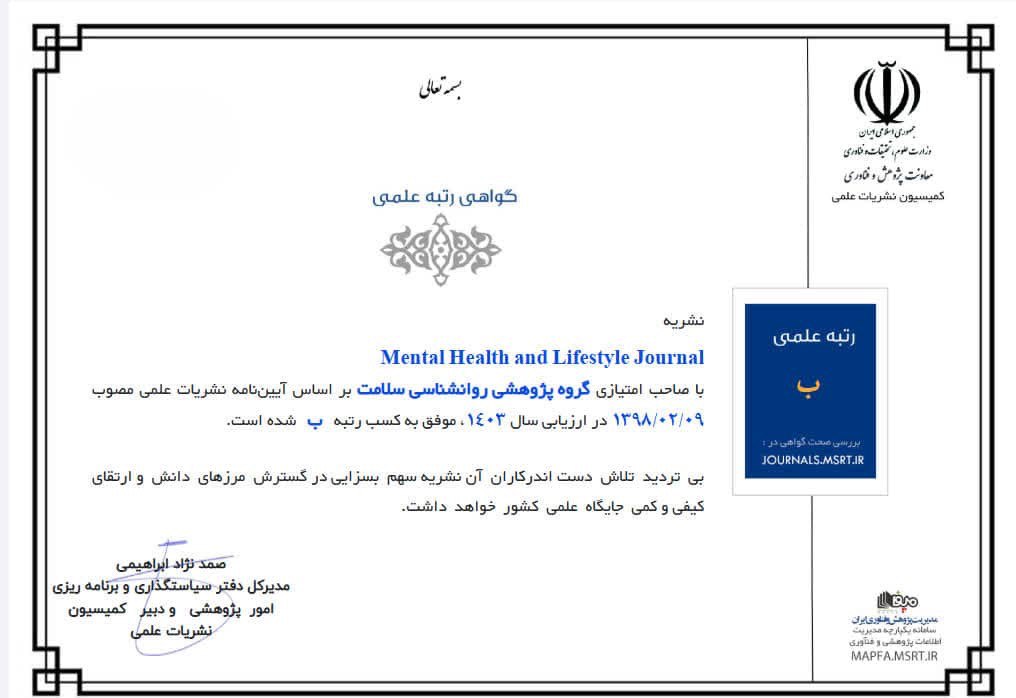Comparison of Biological Habits and Leisure Time Activities Among Native and Non-Native Students in Universities of Kerman Province
Keywords:
Biological habits, leisure time, native students, non-native students, lifestyle, Kerman ProvinceAbstract
The present study was conducted with the aim of comparing the level of biological habits and the ways of spending leisure time among native and non-native students in universities of Kerman Province. The study was applied in purpose and descriptive–comparative (ex post facto) and cross-sectional in method. The statistical population included all associate to doctoral students of universities in Kerman Province during the 2024–2025 academic year. From this population, 360 participants (180 native and 180 non-native students) were selected through convenience sampling. The data collection instrument was the Lifestyle Questionnaire, whose overall reliability was obtained at 0.87 using Cronbach’s alpha. Data were analyzed using SPSS software and the independent t-test. The results indicated that there was a significant difference between native and non-native students in some components of lifestyle. Native students had higher mean scores in the dimensions of “social health,” “spiritual health,” and “disease prevention,” whereas non-native students performed better in the components of “exercise and physical well-being” and “group leisure activities.” Furthermore, the overall mean of biological habits among native students was higher than that of non-native students, although the difference in the total lifestyle score was not statistically significant (p > 0.05). The findings suggest that differences in living conditions and access to supportive resources can influence students’ biological patterns and leisure time behaviors. University-level planning to promote a healthy lifestyle—particularly among non-native students—can play a crucial role in preventing individual and social harm and in improving students’ mental health.
Downloads
References
1. Hoseinzadeh F, Namadi F, Akbarnejad N, Zeynali I, Zarei Pour M. The status of spiritual health and its relationship with academic achievement among Iranian students: A systematic review study. Iranian Nursing Journal. 2025;38(2):221-34.
2. Abbas Pour S, Abbasi Asfjir AA, Rahmani Firozjah A. An analysis of lifestyle in student dormitories: A case study of students residing in the dormitories of Khajeh Nasir al-Din Tusi University of Technology. Journal of Islamic Lifestyle with a focus on health. 2022;6(2):111-22.
3. Mahdi R. Quality of university life from the perspective of native and non-native students at public universities in Tehran. Iranian Cultural Research. 2016;9(2):49-73.
4. Afrooz G. Leisure time is the most valuable moment of human life. Educational and Pedagogical Journal of Peyvand. 2008(445):337-46.
5. MohammadiFarrokhran E, Mokhayeri Y, Tavakoli Z, Mansouri A. Investigating the relationship between sleep quality and mental health among dormitory residents. Journal of Knowledge and Health in Medical Sciences. 2012;7(3):112-7.
6. Zakhireh Dari N, Ahan Jan F, editors. A study of life in dormitories and its impact on academic progress. Fourth National Conference on Law, Social Sciences, and Humanities; 2020.
7. Low BS, Koshy S, Thein KMM, Tayeba S, Saha S. Factors associated with sleep disorders among international university students in Malaysia. Sleep and Vigilance. 2024;8(1):1-8. doi: 10.1007/s41782-023-00259-y.
8. Meyer A, Wissemann K. Controlling parenting and perfectionism is associated with an increased error-related negativity (ERN) in young adults. Social Cognitive and Affective Neuroscience. 2020;15(1):87-95. doi: 10.1093/scan/nsaa018.
9. Wang WC. Exploring the relationship among free time management, leisure boredom, and internet addiction in undergraduates in Taiwan. Psychological reports. 2019;122(5):1651-65. doi: 10.1177/0033294118789034.
10. Butler N, Quigg Z, Bates R, Jones L, Ashworth E, Gowland S, et al. The contributing role of family, school, and peer supportive relationships in protecting the mental wellbeing of children and adolescents. School Mental Health. 2022;14(3):776-88. doi: 10.1007/s12310-022-09502-9.
11. Hadi Afra AY, Nezhadi A. Explaining the role of family in the psychological health of youth (a case study of married students at Kashan University). Journal of Socio-Psychological Harm. 2021;1(11):1-21.
12. Karami A. A comparative study of the mental health of native and non-native students at Islamic Azad University of Parsabad [Master's thesis in Psychology]. Islamic Azad University, Ardabil Branch2016.
13. Hop Wo NK, Anderson KK, Wylie L, MacDougall A. The prevalence of distress, depression, anxiety, and substance use issues among Indigenous post-secondary students in Canada. Transcultural Psychiatry. 2020;57(2):263-74. doi: 10.1177/1363461519861824.
14. Kremer KP, House N. School anxiety and depression among immigrant youth in America: Differences by region of birth and language proficiency. Social Development. 2020;29(1):232-48. doi: 10.1111/sode.12396.
15. Samie Taemeh M, Kashani Vahid L, Vakili S, editors. A comparative study of spiritual vitality, general health, and mental health among outstanding native and dormitory students of the Faculty of Engineering, University of Tehran. Seventh National Conference on Management, Psychology, and Behavioral Sciences; 2023.
16. Kassaw C, Demareva V. Determinants of academic achievement among higher education student found in low resource setting, A systematic review. PLOS ONE. 2023;18(11). doi: 10.1371/journal.pone.0294585.
17. Porcu M, Sulis I, Usala C, Giambona F. Will the gap ever be bridged? A cross-national comparison of non-native students' educational achievements. Genus. 2023;79(1):19. doi: 10.1186/s41118-023-00199-5.
18. McKay S, Veresova M, Bailey E, Lamblin M, Robinson J. Suicide prevention for international students: A scoping review. International journal of environmental research and public health. 2023;20(2):1500. doi: 10.3390/ijerph20021500.
19. Pusztai D, Rozmann N, Horváth É, Szunomár S, Fusz K. Health behavior, sleep quality and subjective health status of foreign students in Hungary. Archives of psychiatric nursing. 2019;33(5):83-7. doi: 10.1016/j.apnu.2019.06.002.
20. Yun CTP, Greenwood KM. Stress, sleep and performance in international and domestic university students. Journal of international students. 2022;12:81-100. doi: 10.32674/jis.v12i1.3299.
21. Santos MA, Godás A, Ferraces MJ, Lorenzo M. Academic performance of native and immigrant students: A study focused on the perception of family support and control, school satisfaction, and learning environment. Frontiers in Psychology. 2016;7:1560. doi: 10.3389/fpsyg.2016.01560.
Downloads
Published
Submitted
Revised
Accepted
Issue
Section
License
Copyright (c) 2025 Sahra Naseri (Author); GholamAli Afrooz; Bahramali Ghanbarihashemabady, Seyed Saeid Sajjadi Anari (Author)

This work is licensed under a Creative Commons Attribution-NonCommercial 4.0 International License.







